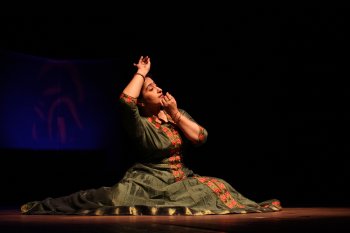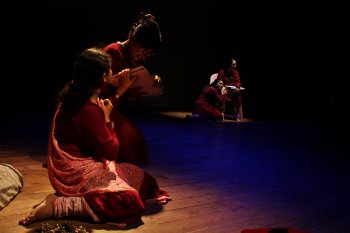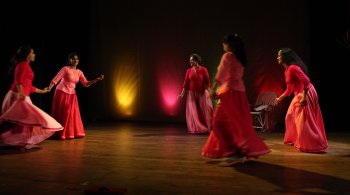
|   |

|   |
Ranan’s double bill performance of ‘Return’ and ‘Dreamed’ - Nita Vidyarthi, Kolkata e-mail: nitavidyarthi@gmail.com July 20, 2011 After a lapse of two years, Ranan presented a new work ‘Return’ and ‘Dreamed,’ a double bill of performance at Gyan Manch, reflecting both roots in classical dance and creative processes. The two productions were independent and distinctly different yet remained connected through the threads of the idiom of Kathak. Kathak was the obvious choice of dance form incorporated in both these productions considering the exhaustive training dancers Debashree Bhattacharya and Vikram Iyengar have undergone in this style. Conceived, choreographed and performed by Debashree, ‘Return’ was her duet with Vikram after ‘Prathama,’ the duo’s first successful endeavour since January 2002. ‘Return’ was also Ranan’s first full-fledged dance oriented production since ‘Rangeeniyan’ in 2005.   The evening began as a search by Debashree and Vikram to re-evaluate and redefine their relationship with the dance form in ‘Return,’ when they find the very soul of the art slipping away from their grasp. A fine idea portrayed through the ankle bells, harmonium and the tabla not in tune when struck, manjira breaking off or The Goddess Saraswati not responding to the prayer “Saraswatimata Sunlijiyemori binti,” Saraswati Vandana in raga Bhupali from the repertoire of Guru Rani Karnaa, the dance composed to show how to approach her - whether by chasing her relentlessly or by allowing her in with humility, respect and desire to serve. Here Saraswati has no religious association but is a mere concept to whom all worshippers (practitioners rightfully) of art serve. Artists surrender to her but she does not serve them. The presentation tries to get an open relationship between performing arts and the performer. A novel idea indeed! But the significance of an illuminated cut-out figure on the dark screen in the middle of the stage was however not clear. Some fine footwork, tukhras and tohras were presented by the two accomplished dancers in the piece with a graceful Panghat mein gat – “Jaal bharaney kaise jaoo” embellished with tatkaar. The Bindadin Thumri “Awata Shyam,” an abhinaya number was equally impressive as was “Shyam Bina Sajani,” a Bandishi Thumri in Tilang, Jhap taal from the repertoire. Execution of tatkaar behind the screen did not allow the audience to enjoy the precision of the movements adequately. Tarana was enjoyable and showed the grip and competence of the dancers in rhythm because of the not-so-easy “Adachautal” set to raga Chandrakauns . Even though the pure dance numbers were not presented conventionally, the vivacity, lines of grace and technical competence in the individual steps added in various ways to the spectators’ enjoyment of nritta and nritya of the Kathak idiom. The tandava aspect was negotiated energetically with immaculate control on the tala in “Dam Damat Damaru” in raga Shankara, Roopak taal by Vikram but a bit more attention to the clarity of the hastas would have enhanced the appeal of the number. Debashree’s performance and controlled power of style was as mature as her abhinaya. But their question of how much of dance today is about an internal experience - both for the performer and the audience remained partly blurred and unanswered. The music and the songs were chosen with care and was a pleasing experience as were the lovely costumes in pastel shades, innovative yet traditional.   ‘Dreamed’ was in full contrast with the first production. Four text excerpts from three wholly unrelated and vastly different sources: ‘Dreaming,’ a play by Peter Barnes, ‘How to cut a Pomegranate,’ a poem by Imtiaz Dharkar, and ‘Shadows of the Pomegranate Tree,’ a novel by Tariq Ali were woven with music impulses from a Turkish album, Jeff Buckley’s “Lilac Wine” “Divinities” (Ian Anderson), Gulun Kokusu Vardi (Erkan Oour, Ismail H Demirciolu), “Scarborough Fair” (Simon and Garfunkel), “Jamaican Farewell” (Harry Belafonte) and an unusual theka of the15 matra Pancham Sawari taal. The production had two fine actresses Anubha Fatehpuria and Dana Roy, a talented dancer Sohini Debnath and an actress and trainee dancer Jayati Chakravarty together with other repertory members of Ranan. It was an exploration of dream, what makes it, the need for dream, do dreams have a story to tell or their source and the space to imagine, to dream and the obstacles that tarnish them. The ambivalent relationship between drama and dance, theatre and dance were inspected through a fluid tapestry of skilful and vivid Kathak by Sohini Debnath and the dancers of the company and the life’s tributaries of hope, desire, joy and despair by Anubha, Dana, Jayati, Indudipa and the rest of the cast, ending on a triumph of hope for happiness. The mythical and symbolic pomegranate grove was the point of focus and the relationships and tensions between and within the texts flowered in many different directions. The treatment of the multi-coloured text had crests and troughs in the sense that at times the weave of the script seemed to sag and at the other enhanced the appeal of the presentation. The best moments were the joyous dancing of the girls around the pomegranate tree and the imagery of grand Aunt Zahra and Zubayda in the past and the present. The director had shown some skilful and artistic handling of the heterogeneous text but the juxtaposition of theatre and dance brought into confrontation two different styles of performance at times. The emotions portrayed by the actors at different levels exude individual talent especially in the first half of the production but the second half stretched into elusive dimensions resulting in monotony. A bit of pruning might have brought some orderliness into the randomly selected narrative to make an otherwise interesting and ambitious production appealing. ‘Dreamed’ has a distinction of personal style but the best part was the wonderful coloured pink-burgundy-maroon costumes, the delicately flowered backdrop resembling a water colour -washed Japanese painting and the pomegranate tree. Vikram and Debashree have always had a keen sense of colour and innovative costume design and both the productions as their earlier ones deserve praise. Light design of ‘Dreamed’ by Sudip Sanyal was brilliant but ‘Return’ could have had some more visible light. An otherwise challenging production with young promising dancers and hardworking actors led by aesthetically conscious director and choreographer. A critic of performing arts, specialising in dance, dance theatre and expressions, and a regular contributor to the Statesman Kolkata in dance, vocal music and theatre. Trained in Kathak, both the Jaipur and Lucknow gharanas, was a disciple of the late Jaikumari, Ram Gopal Misra, Manjulika Roy Chowdhury and Gayatri Chatterjee. Had exposure to Bharatanatyam from Guru Maruthappa Pillai and Manipuri from Guru Bipin Singh and Kalavati Devi. Regular visitor to the festivals of UK and Europe. Also trained in vocal, semi-classical music and Rabindra Sangeet. A Science communicator, Ph.D. in Polymer Science, Commonwealth Scholar and a retired Professor of Chemistry, Nita devotes most of the time on dance and theatre writing. |